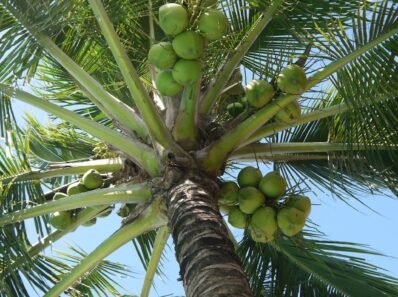The production of coconuts is significant to India’s national economy.
In India, the coconut palm is known as the “tree of heaven” or “Kalpavriksha” since every component of the palm is beneficial to humans.
The coconut tree can yield 50 to 100 coconuts a year and live up to 100 years. Coconut palms can be grown successfully in locations with relatively mild frosts. The Asia-Pacific region contributes 90% of the world’s coconut crop for export.

In India, coconuts are used in food and non-food items. As well as it is used in many traditional rituals.
Food Items –
- Coconut milk and cream: This is made by grating mature coconut meat and pressing it to extract the liquid. Coconut milk contains at least 10% fat, while coconut cream contains at least 20% fat. Used in many Asian dishes.
- Coconut oil: Extracted from dried coconut meat (copra). Used for cooking, baking, and in beauty products. Virgin coconut oil is extracted from fresh coconut meat.
- Coconut flour: Made by grinding dried coconut meat. Used as a gluten-free flour alternative in baking.
- Coconut butter: Made by blending coconut meat until smooth and creamy. Used as a spread or in recipes.
- Coconut chips and flakes: Made by slicing or shredding coconut meat and toasting until crisp. Eaten as a snack or used as a topping.
- Coconut sugar: Made from the sap of the coconut palm flower buds. Used as a sweetener
Non-Food Items –
- Coconut coir: The fiber from the coconut husk. Used for making ropes, mats, brushes, and as a potting medium.
- Coconut charcoal: Made from the coconut shell. Used for water filtration and in barbecues.
- Coconut peat: Made from coconut husk. Used as a soil amendment
- Coconut shell products: Coconut shells can be repurposed into a wide variety of decorative, functional, and sustainable products for the home, kitchen, and crafting. Their natural beauty and eco-friendly nature make them a popular material for artisans and consumers alike
Coconut trees can be used for housing, thatching, hats, baskets, furniture, mats, cordage, clothes, charcoal, brooms, fans, ornaments, musical instruments, shampoo, containers, utensils, oil for fuel, light, ointments, soap, and more, in addition to providing drink, food, and shade. Its leaves are used to construct roofing thatch, baskets, and other items. The apical buds of adult plants make excellent palm cabbage. Its sugar sap, which is tapped from the inflorescence using suitable cuttings, is used to manufacture an alcoholic beverage known as “palm wine,” or Toddy.


